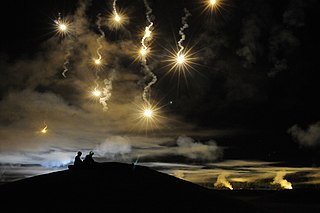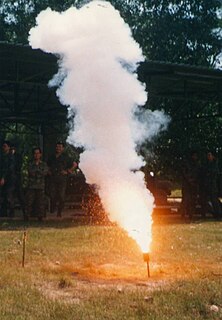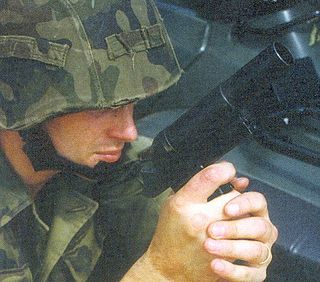Electrothermal-chemical (ETC) technology is an attempt to increase accuracy and muzzle energy of future tank, artillery, and close-in weapon system guns by improving the predictability and rate of expansion of propellants inside the barrel.

A flare, also sometimes called a fusée, is a type of pyrotechnic that produces a bright light or intense heat without an explosion. Flares are used for distress signaling, illumination, or defensive countermeasures in civilian and military applications. Flares may be ground pyrotechnics, projectile pyrotechnics, or parachute-suspended to provide maximum illumination time over a large area. Projectile pyrotechnics may be dropped from aircraft, fired from rocket or artillery, or deployed by flare guns or handheld percussive tubes.

Johann Peter Hebel was a German short story writer, dialectal poet, lutheran theologian and pedagogue, most famous for a collection of Alemannic lyric poems and one of German tales.
Bell-bottoms are a style of trousers that become wider from the knees downward, forming a bell-like shape of the trouser leg.

The Gyrojet is a family of unique firearms developed in the 1960s named for the method of gyroscopically stabilizing its projectiles. Rather than inert bullets, Gyrojets fire small rockets called Microjets which have little recoil and do not require a heavy barrel or chamber to resist the pressure of the combustion gases. Velocity on leaving the tube was very low, but increased to around 1,250 feet per second (380 m/s) at 30 feet (9.1 m). The result is a very lightweight & transportable weapon.

A flare gun, also known as a Very pistol or signal pistol, is a large-bore handgun that discharges flares. The flare gun is typically used to produce a distress signal. It was more often used by sailors to produce sinking signal when attacked by pirates or ship got damaged due to icebergs,etc. A flare gun can be used as a deadly weapon, but that is not its intended function.

A cap gun, cap pistol, or cap rifle is a toy gun that creates a loud sound simulating a gunshot and a puff of smoke when a small percussion cap is exploded. Cap guns were originally made of cast iron, but after World War II were made of zinc alloy, and most newer models are made of plastic. Cap guns get their name from the small discs of shock-sensitive explosive compounds that provide the noise and smoke, effectively the same as the Maynard tape primer and percussion caps used in real firearms of the mid to late 1800s but usually smaller and made from cheap plastic or paper. Some are arranged in plastic rings of eight or twelve. There are also single caps, roll caps, disk caps, and cap strips all of which are actually extremely small versions of percussion fireworks. Armstrong's mixture is often used today as the explosive, but previously the tiny powder charge was a simple mixture of potassium perchlorate, sulfur, and antimony sulfide sandwiched between two paper layers which hold in the gases long enough to give a sound report when the cap is struck.
The Winchester Model 1894 rifle is a lever-action repeating rifle that became one of the most famous and popular hunting rifles of all time. It was designed by John Browning in 1894 and originally chambered to fire two metallic black powder cartridges, the .32-40 Winchester and .38-55 Winchester. It was the first rifle to chamber the smokeless powder round, the .30 WCF in 1895. In 1901 Winchester created the new .32 Winchester Special caliber with production of rifles starting in 1902.

The flaming onion was a 37 mm Hotchkiss revolving-barrel anti-aircraft gun used by the German army at the beginning of World War I, the name referring to both the gun, and especially the flare or tracer ammunition it fired. The American "balloon-buster" ace, Frank Luke, was a prominent victim of later versions of this device, and it was mentioned in Eddie Rickenbacker's book Fighting the Flying Circus and in many "Biggles" stories. Later in the war the term was also applied to any sort of anti-aircraft fire that used a visible tracer, appearing in reports of combat from the Battle of Taranto, for instance.

A tripflare is a device used by military forces to secure an area and to guard against infiltration. It consists of tripwire around the area, linked to one or more flares. When the tripwire is triggered, as by someone unsuspectingly disturbing it, the flare is activated and begins burning. The light from the flare simultaneously warns that the perimeter may have been breached and also gives light for investigating. In defensive operations, tripflares are usually placed in predetermined kill zones with machine guns sighted on them.
Chiappa Firearms, Armi Sport di Chiappa, is an Italian firearms manufacturing company based in Brescia. It was founded in 1958 by Ezechiele Chiappa as Armi Sport. Total unit production is around 60,000 per year. Its U.S. headquarters are in Dayton, Ohio.

The Nambu Type 90 was a flare gun of Japanese origin and manufactured by Nambu. It was used by the Imperial Japanese Navy and came with two or three barrels.

The Smith & Wesson Model K-38 Target Masterpiece Revolver Model 14 is a six-shot, double-action revolver with adjustable open sights built on the medium-size "K" frame. It is chambered for the .38 Special cartridge, and most were fitted with a 6 in (150 mm) or 8+3⁄8 in (210 mm) barrel. A small batch were made with 4 in (100 mm) barrels, and even fewer were made with 5 in (130 mm) barrels. First produced in 1947 and originally known as the K-38 Target Masterpiece, it was renamed the Model 14 in 1957 when all Smith & Wesson revolvers were given numerical model numbers. It is built on the same medium-sized frame (K-frame) as the seminal Smith & Wesson Model 10 revolver. The K-38 model was authorized for duty with the Los Angeles Police Department in the 1960s and early 1970s.
Kim Cloutier is a Canadian-American underwear and fashion model, known for numerous lingerie, swimsuit and cosmetics campaigns.
Tree volume is one of many parameters that are measured to document the size of individual trees. Tree volume measurements serve a variety of purposes, some economic, some scientific, and some for sporting competitions. Measurements may include just the volume of the trunk, or the volume of the trunk and the branches depending on the detail needed and the sophistication of the measurement methodology.

Flare3D is a framework for developing interactive three-dimensional (3D) graphics within Adobe Flash Player and Adobe AIR, written in ActionScript 3. Flare3D includes a 3D object editor and a 3D graphics engine for rendering 3D graphics. Flare3D runs on current web browsers utilizing the Adobe Flash Player, and uses Stage3D for GPU-accelerated rendering. Flare3D has not been under active development since late 2014.

The Kampfpistole or "combat pistol" in English was a flare gun introduced into German service during 1939 and served throughout World War II.

The SPSh-44 is a Soviet signal pistol.













